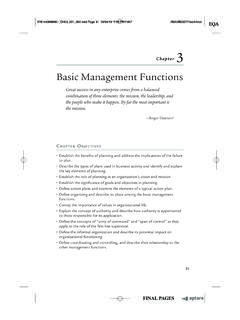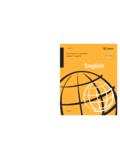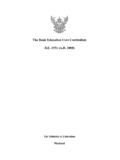Transcription of Active Teaching Strategies and Learning Activities
1 5/15/09 4:40 PM Page 162. 9. CHAPTER. Active Teaching Strategies and Learning Activities While one person hesitates because he feels inferior, the other is busy making mistakes and becoming superior. Henry C. Link Striving for success without hard work is like trying to harvest where you haven't planted. David Bly OBJECTIVES Readers will be able to: 1. Define and describe Active Teaching Strategies and Learning Activities 2. Identify and describe the positive results of using Active Teaching strate- gies and Learning Activities 3. Name the language domains to be supported by Active Teaching Strategies and Learning Activities 4. Describe and give examples of Active Teaching Strategies and Learning Activities that are connected to content and language objectives 5. Demonstrate examples of Active Teaching Strategies and Learning activi- ties in a diverse health education classroom 6. Describe how a teacher can modify lesson Activities Introduction Scores of classroom observations and discussions by the authors with health education professionals around the country clearly indicate that far too many secondary health education classroom teachers continue to dominate their instruction with traditional methods.
2 These include methods such as lecture (teachers talk and students listen), passive reading or watching a video, and independently completing worksheets. These methods are used despite the strong evidence that Learning is often better achieved by using other methods of instruction (O'Malley & Chamot, 1990; Muth & Alvermann, 1999; Buehl, 2001; Marzano, Pickering, & Pollock, 2001). Jones and Bartlett Publishers, LLC. NOT FOR SALE OR DISTRIBUTION. 162. 5/15/09 10:00 AM Page 163. Introduction 163. As you may recall, there are eight National Health Education Standards (see Appendix A) (Joint Committee on Health Education, 2007). Look care- fully at the third word in each standard. Standard 1: Students will comprehend concepts related to health promo- tion and disease prevention to enhance health. Standard 2: Students will analyze the influence of family, peers, culture, media, technology, and other factors on health behaviors. Standard 3: Students will demonstrate the ability to access information, products, and services to enhance health.
3 Standard 4: Students will demonstrate the ability to use interpersonal communication skills to enhance health and to avoid or reduce health risks. Standard 5: Students will demonstrate the ability the use decision-making skills to enhance health. Standard 6: Students will demonstrate the ability to use goal-setting skills to enhance health. Standard 7: Students will demonstrate the ability to practice health- enhancing behaviors and to avoid or reduce health risks. Standard 8: Students will demonstrate the ability to advocate for personal, family, and community health. There are three different action (verb) terms used in the eight National Health Education Standards. They are: comprehend, analyze, and demon- strate. Each of these three terms suggests a very different level of student pro- ficiency, and, therefore, require a different level of instruction. 1. Comprehend (used one time): to understand or to know 2. Analyze (used one time): to examine carefully and critically 3.
4 Demonstrate (used six times): to explain by showing These three terms were carefully selected by the Joint Committee on Health Education Standards to illustrate the essence of health literacy. Health literacy is the capacity of an individual to obtain, interpret, and understand basic health information and services and the competence to use such information and services in ways which are health- enhancing . (2007, 6). Standard 1 is the only one of the National Health Education Standards that focuses on basic knowledge and comprehension (Joint Committee on Health Education, 2007). This level of proficiency typically requires the stu- dents to perform at a relatively low cognitive level by merely having to tell, list, name, repeat, recall, or label health information. Seven of the eight standards focus on students Learning and demonstrating various skills and abilities. For example, athletes do not typically achieve proficiency by Jones and Bartlett Publishers, LLC.
5 NOT FOR SALE OR DISTRIBUTION. 5/15/09 10:00 AM Page 164. 164 Chapter 9 Active Teaching Strategies and Learning Activities merely reading about the sport ( , history or rules) or watching it played proficiently. Athletes achieve proficiency in a sport by actively practicing and participating in that sport. Likewise, students will learn the skills repre- sented in the National Health Education Standards by practicing and par- ticipating in authentic (or near-authentic) Activities designed to develop those skills. Simply reading about these critical skills (such as decision making, ad- vocacy, and communication) will not develop them to the desired degree. This chapter will describe Teaching Strategies and Learning Activities that are designed to increase health-related knowledge and skill. As you read about the various techniques, keep in mind the use of the four language domains reading, writing, listening, and speaking that are essential in- structional elements in language diverse health education classrooms.
6 Question What Are Active Active Learning refers to the level of academic student engagement in and Teaching Strategies out of the classroom. These Teaching techniques are intended to make the and Learning students Active (rather than passive) participants in Learning . Learning im- Activities ? portant health knowledge and skill is not unlike Learning many new skills, be it a physical skill ( , kicking a ball), a mental skill ( , decision making), or a social skill ( , communication). Many individuals learn best and be- come proficient in skills by practicing them rather than merely being a spec- tator to the skill, such as listening to teachers talk about the skill, reading about the skill, or watching others perform the skill (Hermin & Toth, 2006). Active , hands-on Teaching Strategies and Learning Activities are designed to take students out of their books, sometimes out of their seats, sometimes out of the classroom, sometimes out of their school, and sometimes out of their familiar ways of thinking .
7 Active , hands-on Teaching Strategies and Learning Activities are intended to make students Active participants in their own Learning (Silberman, 1996; Buehl, 2001). Two important terms are frequently used in this chapter: Teaching strate- gies refer to the structure, system, methods, techniques, procedures, and processes that a teacher uses during instruction. These are Strategies the teacher employs to assist student Learning . Learning Activities refer to the teacher-guided instructional tasks or assignments for students. These are stu- dent Activities . The terms Teaching strategy and Learning activity do not exclusively imply Active or passive instruction. For example, a teacher may select a lecture Teaching strategy where the students are expected (as their Learning activity). to simply listen. Conversely, a teacher may select a problem-based Teaching strategy where the students are expected (as their leaning activity) to discover that they need to learn something in order to solve the problem.
8 Jones and Bartlett Publishers, LLC. NOT FOR SALE OR DISTRIBUTION. 5/15/09 10:00 AM Page 165. Question 165. Question What Language When creating or selecting Teaching Strategies and Learning Activities in lan- Domains Do Active guage diverse classrooms, teachers should consider four language domains Teaching Strategies (Echevarria, Vogt, & Short, 2004): and Learning Activities Support? 1. Reading: Students are able to comprehend written or printed material/. information, such as letters, numbers, figures, and signs. 2. Writing: Students are able to communicate information in written or printed words. 3. Listening: Students are able to actively comprehend oral language from a variety of speakers. 4. Speaking: Students are able to say words, talk, express ideas, and converse in a variety of settings. In a language diverse classroom, teachers are encouraged, and expected, to select Teaching Strategies and Learning Activities that support multiple language domains.
9 The Active Teaching Strategies and Learning Activities listed at the end of this chapter in Question offer several multiple- domain examples. Here is an example of a multiple-domain health education Learning activity that incorporates and requires student reading, writing, listening, and speaking: Activity: Health vocabulary Step 1: Students in small group teams complete a worksheet matching (writ- ing) key vocabulary terms to the term's definition. (Target language domain: reading, writing, speaking, and listening). Step 2: Students turn worksheets over (answers down). One student, randomly selected by the teacher ( , student wearing the most red) looks at the team's completed worksheet and orally quizzes the students, in turn. Repeat with an- other student conducting the team quiz. (Target language domain: reading, speaking, and listening). Teacher Note: The teacher may, or may not, choose to provide correct answers after Step 1. Step 3: The teacher randomly hands out slips of paper ( , 10) to 10 students and asks each to stand.
10 There are 2 items on each slip of paper. 1. A key vocabulary word from the worksheet. 2. A key definition from the worksheet, but not the definition for the word above. (Target language domain: reading). Step 4: The teacher randomly picks 1 of the 10 standing students to read the definition on the slip of paper. The student who has the paper with that defin- ition says the term, reads the definition on his or her slip of paper, then sits down. Continue until all 10 students are seated. (Target language domain: reading, speaking, and listening). Step 5: Repeat Steps 1 through 4 with 10 other students. Jones and Bartlett Publishers, LLC. NOT FOR SALE OR DISTRIBUTION. 5/15/09 10:00 AM Page 166. 166 Chapter 9 Active Teaching Strategies and Learning Activities Teacher's Note: 1. The teacher may want to use a stop watch to determine the length of time it takes a group from start to finish (all students seated) to conduct some friendly competition between and among student teams and/or classes.











![The Ontario Curriculum, Grades 1-8, Language [revised] 2006](/cache/preview/d/5/3/5/d/c/7/4/thumb-d535dc7439a04910d8a17bf7f1d6b83f.jpg)


